- 1School of Environment and Resources, Southwest University of Science and Technology, Mianyang, China
- 2State Key Laboratory of Oil and Gas Reservoir Geology and Exploitation, Chengdu University of Technology, Chengdu, China
Most of the significant petroleum- and coal-bearing sedimentary basins in Northeast Asia originated via rifting and thermal subsidence during the Late Jurassic-Early Cretaceous, followed by basin inversion in the Late Cretaceous. However, the tectonic background governing these basin prototype shifts has not been fully explored. The unconformities are excellent archives of plate boundary interactions and geodynamic switches in subduction zones. The Eastern Heilongjiang Province (EHLJ), Northeast China (NE China), comprises a series of Mesozoic-Cenozoic residual basins with well-preserved successions and provides significant insights into the tectonic characteristics and background of Northeast Asia. Mesozoic unconformities and large-scale contractional structures in the basins mark a series of important tectonic transitions in Northeast Asia. Based on the synthesis information of regional Mesozoic unconformities identified in the seismic reflection profiles and field outcrops of EHLJ, the tectonic characteristics and geodynamic background of the Mesozoic continental margin basins in Northeast Asia are analysed. The Middle-Upper Jurassic/basement unconformity (U1) can only be found in some areas of the Sanjiang and Hulin basins. It was a response to the continental collision of Siberia and the northern China–Mongolia tract along the Mongolia–Okhotsk suture during the Jurassic. The Paleo-Pacific Plate rapidly subducted in the NNW direction towards the eastern margin of Eurasia in the early Lower Cretaceous resulting in a mass of strike-slip faults and the widespread absence of deposits (Valanginian) (U2) in the EHLJ. Because of the subduction slab rollback of the Paleo-Pacific Plate during the late Lower Cretaceous, the local asthenospheric material upwelled, and fault and volcanic activities intensified in Northeast Asia. The Lower Cretaceous Dongshan Formation (Fm)/Muleng Fm unconformity (U3-1) reflects a specific scale of bimodal magmatism in the Songliao Basin and the EHLJ. The Pacific Plate subducted in a transformation from NNW to WNW during the early Upper Cretaceous (Cenomanian). The Houshigou Fm (Qixinhe Fm)/Lower Cretaceous angular unconformity (U3) reflects that on the basins experienced denudation after being extensively uplifted from the subduction events. With the subduction of the Kula Plate, a compression stress field during the later Upper Cretaceous Period controlled NE China. The basins underwent a widely compressive deformation, accompanied by large-scale thrusts, denudation and deplanation, resulting in Paleogene/Cretaceous unconformity (U4) was formed.
1 Introduction
Several significant petroleum- and coal- bearing sedimentary basins exist in Northeast Asian, such as the Songliao, Sanjiang, Hailar, Erlian, and Sanjiang-Middle Amur basins (Cao and Zheng, 2003; Wu et al., 2004; Liu et al., 2006; Jia and Zheng, 2010; Men et al., 2010). Previous studies have proposed that these basins have undergone underwent rifting, thermal subsidence; and then basin inversion since the Mesozoic (Song, 1997; Wang et al., 2016; Guo et al., 2018). It is widely accepted that the two-sided active continental margin tectonics of the Mongolia–Okhotsk Belt, with suturing in the north, and the Pacific Plate subduction in the east during the Mesozoic are caused the series of basin tectonics (Northrup et al., 1995; Maruyama et al., 1997; Song, 1997; Wang et al., 2001; Zhang et al., 2012; Song et al., 2015; Cui et al., 2020).
The NE Asian margin has undergone prolonged Paleo-Pacific subduction and the accretion of island arcs, oceanic plateaus and microcontinents since the early Mesozoic (Meng, 2003; Zhang et al., 2017b). Two decisive factors caused these tectonic movements. One is the closure of the Mongolia-Okhotsk Sea in the north during the Late Jurassic-Early Cretaceous (Halim et al., 1998; Zhang et al., 2001; Ren et al., 2002; Kirillova, 2003; Liu et al., 2004; Metelkin et al., 2007; Yin, 2010; Zhu et al., 2010; Guo et al., 2018); the other is the ancient Pacific Plate subduction beneath the Eurasia Plate in the east during the Mesozoic (Faure et al., 1995; Shao, 1995; Liu et al., 2001; Kirillova, 2003; Li et al., 2003; Huang and Zhao, 2006; Chen et al., 2008; Duan et al., 2009; Cho et al., 2016). Several studies have proposed significant collision between the Okhotomorsk Block and Northeast Asia in the Late Cretaceous (Yang, 2013; Zhang et al., 2017b). This tectonic configuration has created complicated structural patterns within Northeast Asia (Song et al., 1996; Wang, 1997; Cao and Zheng, 2003; Kirillova, 2003; Wen et al., 2008). However, these geological events in Northeast Asia are poorly explained using a successive tectonic and geodynamic model of the eastern Asia continental margin (Yang, 2013; Lee, 2018) because the complex evolution of the NE Asian margin involves deformations of extension, contraction and strike-slip related to active margin tectonics.
The tectonic history, including mantle dynamics, kinematic interactions between converging continental and oceanic plates, and variations in the convergence and slab rollback rates, can be recorded on the surface and at shallow lithospheric depths as tectonic responses (Dilek and Sandvol, 2009; Zhang et al., 2015; Zhang et al., 2017b). As boundaries of stratigraphic units, the unconformities are common phenomena at shallow lithospheric depths (Steno, 1669) and can be divided into angular unconformity, nonconformity and disconformity. Their formation results from sea-level changes and regional tectonic processes. They are significant in the crust’s evolution and deformation mechanisms and provide vital evidence and guidance in reconstructing orogenic phases or dividing geotectonic cycles (Walter, 1952; Heller et al., 1988; He, 2007). Therefore, unconformities are excellent archives of plate boundary interactions and geodynamic switches in subduction zones (Wilson, 1991; Zhang et al., 2015).
In the Eastern Heilongjiang Province (EHLJ), NE China, a series of Mesozoic-Cenozoic residual basins are distributed in the pre-Jurassic basement (Zhao et al., 2017). With the well-preserved Mesozoic–Cenozoic successions, the basins provide significant insights into Northeast Asia’s structure characteristics and tectonic. Mesozoic unconformities and large-scale contractional structures in the basins mark a series of crucial tectonic transitions (Zhang et al., 2012; Zhang et al., 2015; Zhao et al., 2017). This study provides comprehensive synthesis information of regional Mesozoic unconformities from high-resolution seismic profiles and field investigations. Then the tectonic kinematics of Northeast Asia during the Mesozoic are discussed and analysed, and the tectonic characteristics and geodynamic background of the Mesozoic continental margin basin’s evolution in Northeast Asia are explored.
2 Geological Setting
Located in NE China, the EHLJ contains several adjacent Mesozoic-Cenozoic basins, including Sanjiang, Boli, Jixi, Hulin, Hegang, Tangyuan, and Fangzheng basin (Jia and Zheng, 2010; Men et al., 2010). They are separated by the NNE-trending Jiamusi-Yitong Fault (JYF) and the NS-trending Jiayin-Mudanjiang Fault (JMF). West of the EHLJ is the Zhangguangcai Range, and east is the Nadahada Range, between which there is the NS-trending Dahezhen Fault (DZF). Southeast of the EHLJ is the Yanji Fold Belt with the NE-trending Dunhua-Mishan Fault (DMF) between them (Figure 1).
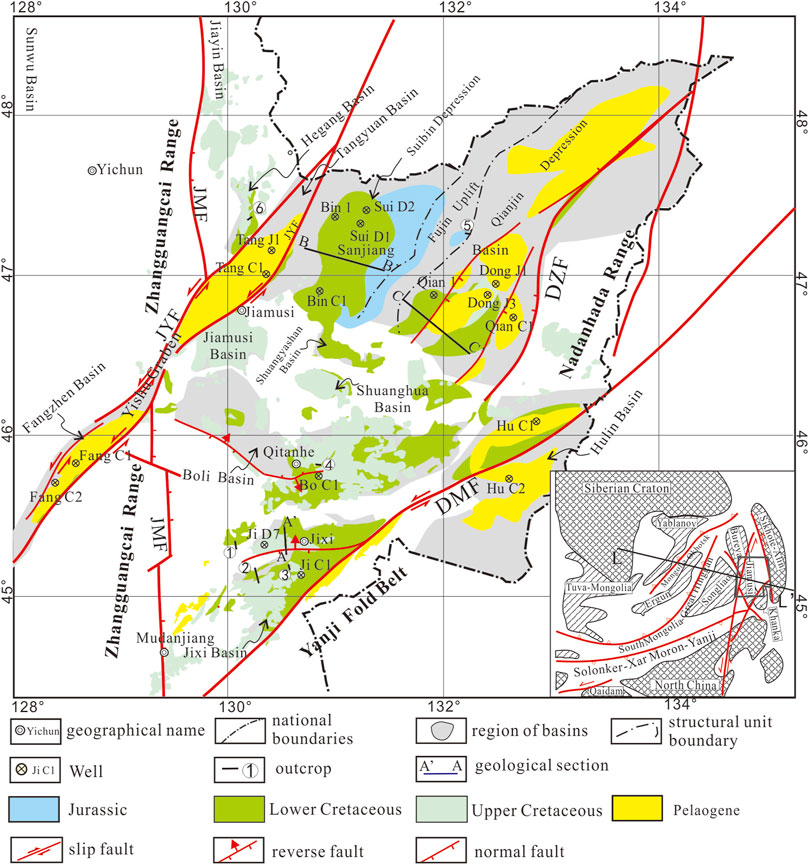
FIGURE 1. Distribution of Mesozoic-Paleogene sedimentary strata and tectonic framework map of the EHLJ (modified after Zhang et al., 2015; Zhao et al., 2017; Jia and Zheng, 2010; Men et al., 2010), showing the locations of seismic profiles, outcrops, and drill holes. A tectonic sketch map (inset, bottom right) shows the primary subdivisions of central and eastern Asia and the location of the study areas (modified after Zhou et al., 2009). Abbreviations: JYF, jiamusi-yitong fault; JMF, jiayin-mudanjiang fault; DZF, dahezhen fault; DMF, dunhua-mishan fault.
The EHLJ’s basement comprises three large tectonic units, including the Jiamusi, Khanka, and Bureya blocks (Zhang and Shi, 1993; Zhang and Zhang, 1999; Wang et al., 2009; Meng et al., 2010; Zhang et al., 2010), primarily comprising of the Archean Mashan group and the Late Hercynian to Indo-Chinese epoch Heilongjiang group Complexes and Permian granites (Zhou et al., 2010; Sun et al., 2013). The EHLJ’s sedimentary cover the contains marine and terrestrial deposits of the Upper Jurassic- Cenozoic (Kirillova, 2003; Yang et al., 2007; Zhu and He, 2007; Sha and Galina, 2009).
Figure 2 summarises the inter-correlation of stratigraphic units of the EHLJ’s sub-basins (Zhao et al., 2017). The Middle-Upper Jurassic sequence includes terrestrial deposits, including the Suibin (Peide) Formation (Fm) and the Dongrong (Qihulin) Fm. Figure 2 shows they are found only in the northern Sanjiang basin and the eastern Hulin basin (Figure 1). The Lower Cretaceous sequence is widely distributed in EHLJ, including the Didao Fm, the Chengzihe Fm, the Muleng Fm and the Dongshan Fm. However, complete successions are conserved only in the Hulin basin, the Jixi basin, and part of the Sanjiang basin. The Didao, the Chengzihe and the Muleng Fms were deposited in terrestrial environments from the Hauterivian to early Albian (Sha and Galina, 2009). Unconformably overlying the Muleng Fm, the Dongshan Fm is dominated by tuffs and basalts (also Albian). Locally distributed in the Sanjiang, the Hegang, the Jixi, and the Boli basins, the Upper Cretaceous sequence in the EHLJ primarily comprises the Houshigou Fm (also the Qixinghe and Yanwo Fms). Multi-coloured, sandy conglomerates deposited in a fluvial environment dominate this Cenomanian to Santonian sequence.
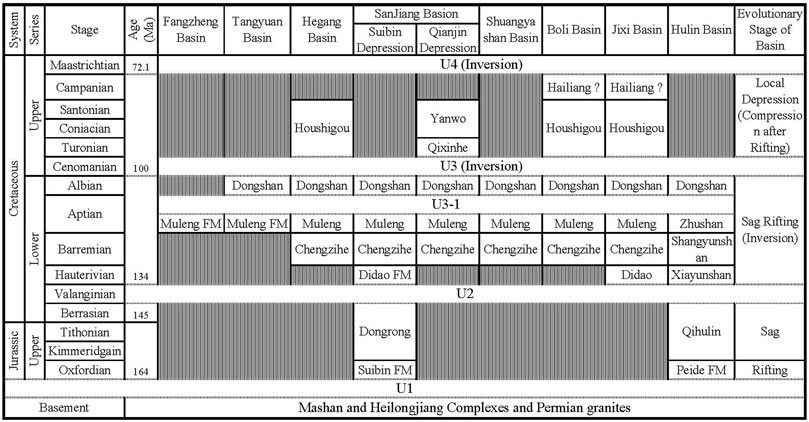
FIGURE 2. Stratigraphic classification and comparison of the primary basins in the EHLJ (modified after Sha and Galina, 2009; Zhang et al., 2015; Zhao et al., 2017; He et al., 2009). Chronostratigraphic correlations are from the 2013 Geological Time Scale (Walker et al., 2013). Note: U1–U4 are unconformities; U1 = Jurassic/basement; U2 = Cretaceous/Jurassic; U3 = Upper Cretaceous/Lower Cretaceous; U3-1 = Dongshan Fm/Muleng Fm; U4 = Paleogene/Cretaceous.
3 Methodology
This study’s methods and new integrated data include outcrop surveys, drill core observations, well logging data analysis and 2D/3D seismic profile interpretations.
The study area’s stratigraphic information was based on the 1:200000 China Regional Geological Survey Reports. The outcrop observations along the basin margins were from fieldwork. Most structural information about outcrops was collected from investigating exposed sections in several quarries and open-pits that benefit from exploitation depth and variably orientated walls, allowing for 3D analyses. Additional information was obtained from numerous road slopes.
The Daqing Oilfield Co. Ltd., a subsidiary of PetroChina provided the seismic reflection data and related drilling data. With a length of over 2,000 km, 3D and 2D seismic reflection data mostly stretch across the central zone of the basins and were used to analyse their subsurface structures. Furthermore, drilling data and cores were from over 200 oilwells supplied by the Daqing Oilfield, which provided the related geological information for seismic interpretation, and constraining the strata units.
4 Mesozoic Unconformities
4.1 Middle-Upper Jurassic/Basement Nonconformity (U1)
The Middle-Upper Jurassic Dongrong and the Suibin Fms in the EHLJ are limitedly distributed in the Sanjiang Basin’s Suibin Depression. However, the Peide and Qihuilin Fms have limited distribution in the Hulin Basin (Figure 1). Therefore, the U1 nonconformity can only be found in some areas of the Sanjiang and Hulin basins. The main characteristic of the selected seismic profile is that a regime of uniform reflections in the underlying basement changes to chaotic and sub-parallel reflections in the overlying Middle-Upper Jurassic sequence (Figure 3B).
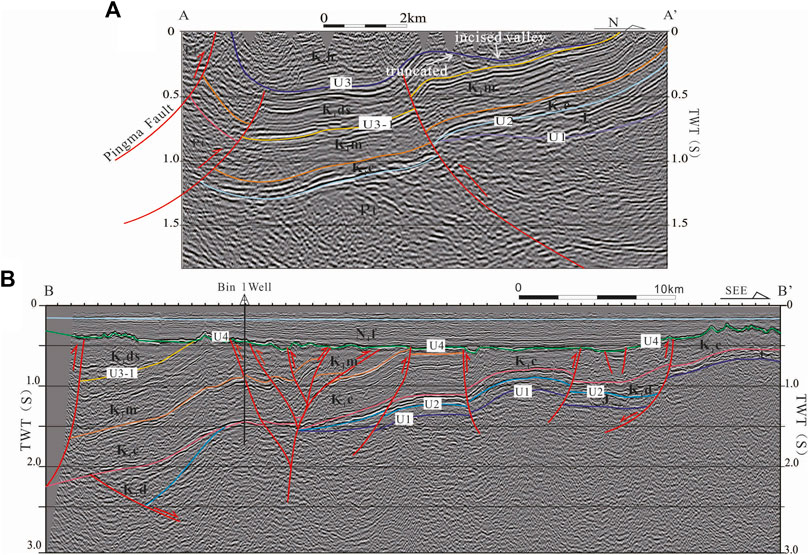
FIGURE 3. Geological interpretations of seismic reflection profiles A-A’ and B-B’ (after Zhao et al., 2017) showing five unconformities (i.e., U1, U2, U3, U3-1, and U4). (A) showing four unconformites in Mesozoic. (B) showing five unconformites. Furthermore, these profiles show a transition from fault (half) graben of the K1d period to a depression of the K1c and K1m periods. Symbols and abbreviations: J2-3, Middle-Upper Jurassic; K1, Lower Cretaceous; K2, Upper Cretaceous; K1d, Didao Fm; K1c, Chengzihe Fm; K1m, Muleng Fm; K1ds, Dongshan Fm; K2h, Houshigou Fm; E1-2b, Wuyun Fm and Xin’Anchun Fm; E2d, Dalianhe Fm; E3b, Baoquanling Fm; N1f, Fujing Fm. See Figure 1 for the location.
4.2 Lower Cretaceous/Jurassic Angular Unconformity (U2)
The unconformity found at the base of the Lower Cretaceous Didao and Chengzihe Fms is angular to the underlying strata. In the selected seismic section of the Suibin Depression, the Dongrong and the Suibin Fms are chaotic and sub-parallel reflections, whereas the overlying Didao and the Chengzihe Fms are parallel and sub-parallel reflections (Figure 3B). Furthermore, the chaotic characteristics in the lower strata turn into parallel and sub-parallel reflections in the Didao and the Chengzihe Fms in the Jixi Basin (Figure 3A). Some outcrops show that the Lower Cretaceous Muleng Fm directly covered the Pre-Mesozoic basement (Zhao et al., 2012).
Because Jurassic is only confined to the interior of individual basins and is absent at the basin margins, only the nonconformity between the Chengzihe Fm and the underlying ancient basement can be seen in the field outcrop. A typical outcrop is exposed to the side of the road from Guangyi Town to Hongxin Town (Figure 4). Two sets of rocks occur under the surface of the unconformity: one is a Proterozoic migmatitic granite cut by multiple granite dikes; the other is strongly deformed metamorphic rock containing dark grey schist, gneiss, and marble (Figure 4B). Overlying the unconformity, the Lower Cretaceous Chengzihe and the Muleng Fms are primarily grey and grey-white coarse sandstone and a coal seam (Figures 4C,E). The bedrock’s orientation of the Muleng Fm is 165°∠34°. In the upper outcrop, the Muleng and Houshigou Fms are involved in a large anticline. The Houshigou Fm comprises conglomerate or interbedded conglomerate and sandstone (Figures 4D,F) at 340°∠40° and 89°∠35°, respectively. It is speculated that a major thrust fault has developed in the middle of the section.
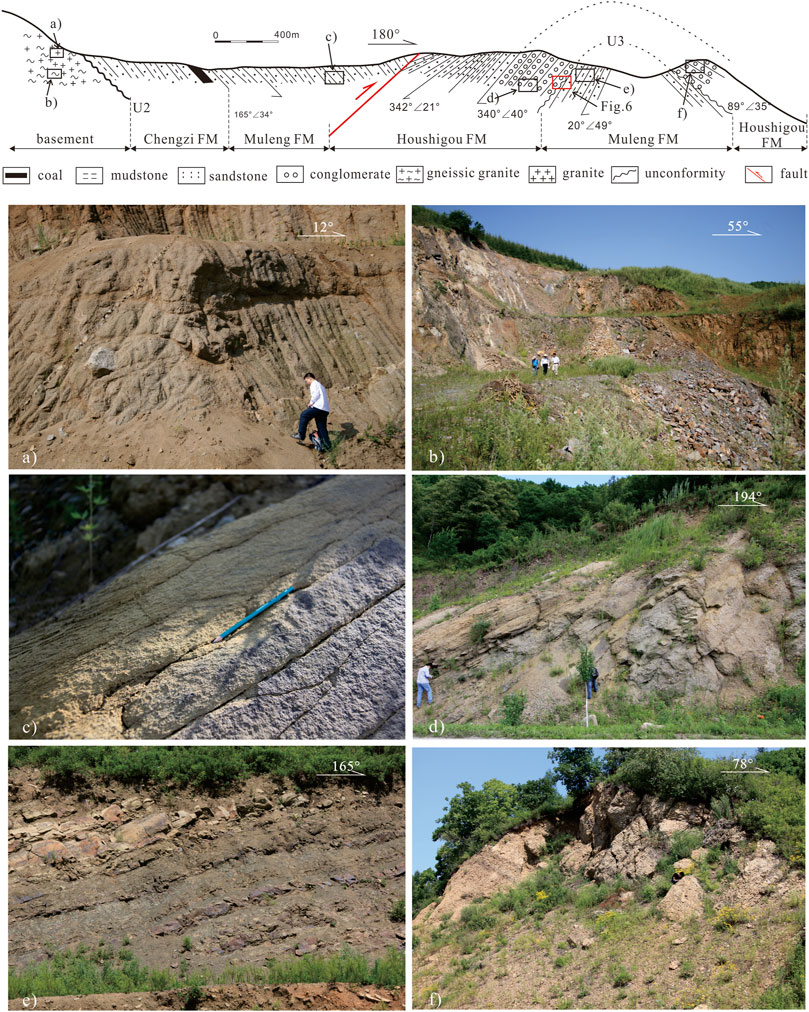
FIGURE 4. Outcrop on the side of the road from Guangxin Town to Hongxin Town, showing two unconformities between the Lower Cretaceous Chengzihe Fm and the Pre-Mesozoic basement, and between the Houshigou and Muleng Fms. An anticline on the upper outcrop is also shown. (A) Proterozoic migmatitic granite, which has been cut by multiple granite dikes. (B) Strongly deformed Proterozoic metamorphic rock containing dark grey schist, gneiss, and marble. (C) Grey and grey-white coarse sandstone of the Muleng Fm, oblique bedding is developed. (D) Interbedded conglomerate and sandstone of the Houshigou Fm. (E) The Muleng Fm, the upper part is grey and grey-white coarse sandstone, the lower part is grey-black siltstone and silty mudstone. (F) The thick beds of conglomerate of the Houshigou Fm.
4.3 Lower Cretaceous Dongshan Fm/Muleng Fm Disconformity or Angular Unconformity (U3-1)
The U3-1 unconformity is on the top of a sequence of the delta plain and lacustrine facies in the Muleng Fm and is overlain by pyroclastic rocks of the Dongshan Fm (Sha and Galina, 2009; Zhang et al., 2016). The 1:2,00,000 China Regional Geological Survey Reports and field outcrops show the conformity, disconformities or local angular unconformities. The seismic reflection profiles in the Jixi and Sanjiang basins show that the lower reflection of the U3-1 has no noticeable erosion, a type of contact with either conformity or disconformity (Figure 3).
An angular unconformity occurs the outcrops between the Dongshan and Muleng Fms (Figure 5). The underlying Muleng Fm contains thick grey-white sandstone intercalated with a coal seam whose attitude is 153°∠37°. However, the Dongshan Fm comprises disordered conglomerates, containing mainly of grey-white sandstones and lava (felsite) pebbles and cobbles with round shapes.
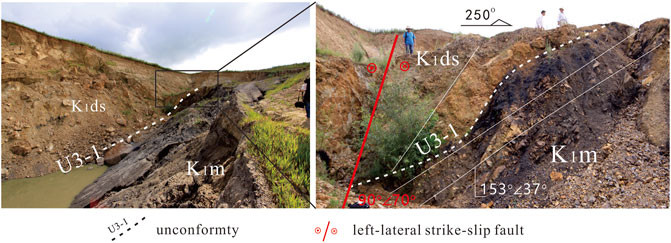
FIGURE 5. The outcrop in an abandoned mine in Dongxing Town, Hegang City. It shows an unconformity between the Lower Cretaceous Dongshan and Muleng Fms, and a strike-slip fault cutting the strata of an attitude of 90°∠70°. The right picture showing the Muleng Fm contains thick grey-white sandstone intercalated with a coal seam below the (angular) unconformity, whereas the Dongshan Fm comprises of disorderly conglomerates above the unconformity.
4.4 Upper Cretaceous Houshigou Fm (Qixinhe Fm)/Lower Cretaceous Angular Unconformity (U3)
Outcrops with angular unconformity between the Dongshan and the Muleng Fms are widely distributed in the Jixi and the Boli basins. In outcrop 2 (Figure 4), the Muleng Fm underlies the unconformity, with an attitude of 340°∠40° and the Houshigou Fm overlies the unconformity, with an attitude of 20°∠45° (Figure 6).
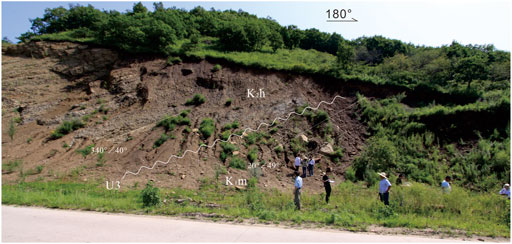
FIGURE 6. Angular unconformity between the Houshigou and Muleng Fms (U3) (see Figure 4 for the locations).
On the selected seismic reflection profile in Figure 3A, the strata underlying the unconformity’s surface have been denuded, and an incised valley can be observed in some areas.
4.5 Paleogene/Cretaceous Angular Unconformity (U4)
The U4 unconformity is widespread in the EHLJ, noticeable in seismic profiles. For instance, an angular unconformity occurs between the Paleogene (or Neogene) and Cretaceous in Figures 3, 7. Below the unconformity, thrust faults are well developed and the strata exhibit strong denudation and deformation due to the compression associated with the thrusting showing that the EHLJ underwent widespread tectonic activity at the end of the Cretaceous.
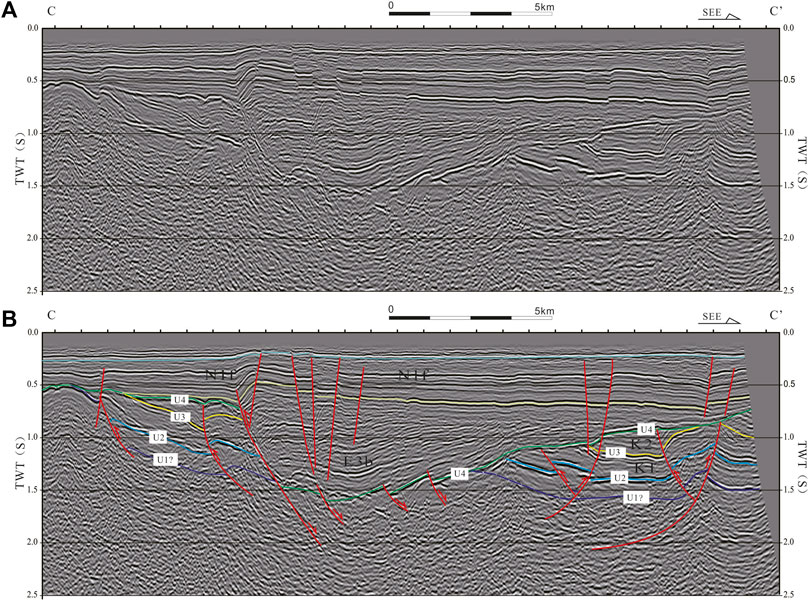
FIGURE 7. Seismic reflection profile C-C’ (A) and related geological interpretation (B), showing the characteristics of the U4 unconformity (see Figure 1 for the location). A cluster of Cenozoic faults occurs above the Mesozoic faults. Symbols and abbreviations are the same as those in Figures 2, 3.
5 Discussion
The complex evolution of the NE Asian margin involves deformations of extension, contraction and strike-slip related to active margin tectonics. Some geodynamic models have been previously established (Faure et al., 1995; Northrup et al., 1995; Wang, 1997; Kirillova, 2003; Wen et al., 2008); however there is a lack of sufficient evidence and systematic understanding of the evolution process since the Mesozoic. Based on the five regional Mesozoic unconformities, combined with the geotectonic background (Zhang et al., 2012; Zhang et al., 2015; Zhao et al., 2017), we correlate the identified unconformities with the Mesozoic continental margin in Northeast Asia and establish evolution models (Figures 8, Supplementary Material).
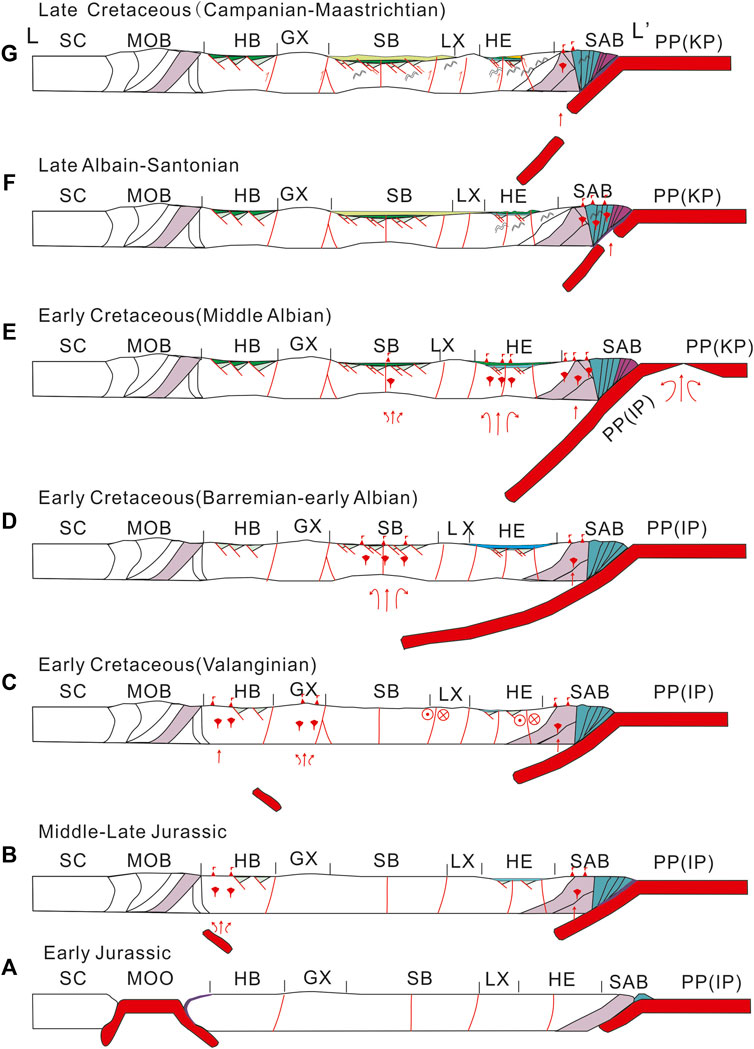
FIGURE 8. The tectonic evolution of NE China and its geodynamic backgrounds during the Mesozoic era. It shows that two-sided active continental margin tectonics of the Mongolia–Okhotsk Belt suturing in the north, and the Pacific Plate subduction in the east controlled the evolution (Wang et al., 2016). It also shows the changes towards the increasing dominance of the Pacific Plate subduction (Li et al., 2012). Abbreviations: SC, siberian craton; MOO, mongolia–okhotsk ocean; MOB, mongolia–okhotsk orogenic belt; HL, hailer basin; GX, greater khingan range; SB, songliao basin; LX, lesser khingan range; HE, EHLJ; SAB, sikhote-alin orogenic belt, PP, pacific plate, also called Izanagi (180–85 Ma) and Kula (85–70 Ma) plates during the Cretaceous (Maruyama et al., 1997); IP, izanagi plate; KP, kula plate.
5.1 The Transitional Environment of Convergent Orogeny and Intra-Continental Extension During the Jurassic
The Mongolia-Okhotsk Ocean’s northward subduction began at the end of the Lower Jurassic Period and ended during the Middle-Upper Jurassic Period (Zonenshain et al., 1990; Zorin, 1999), and the Ocean began to close (Huang et al., 2021) (Figure 8A). Located at the Southern Ocean’s active continental margin (Zorin, 1999), the Ergun-Greater Khingan Range composite plates generated massive N-S thrusts during the subduction, while the Nadanhada Arc Terrane began to accrete onto the East Asian Continent (Whan, 2006; Isozaki et al., 2010; Khanchuk et al., 2016; Yang et al., 2017).
Crustal shortening prevailed in Northeast Asia during the Middle to early Upper Jurassic times in response to the continental collision of Siberia and the northern China–Mongolia tract along the Mongolia–Okhotsk suture (Meng, 2003) (Figures 8A,B). Following the subducting plate’s partial melting, magma intrusion and large-scale volcanic activity were generated by lithospheric extension and mantle upwelling due to slab break-off from the Mongolia-Okhotsk subducting plate (Ma et al., 2017; Tang et al., 2018). During this period, a complex Middle and Upper Jurassic passive continental margin rift formed with a near NS direction in Northeast Asia (Figure 8B). Volcano-sedimentary formations of the Suibin and Peide Fms were deposited in the eastern basin, whereas those of the Tamulagou and Maketouebo Fms were deposited in the western basin (Figure 9).
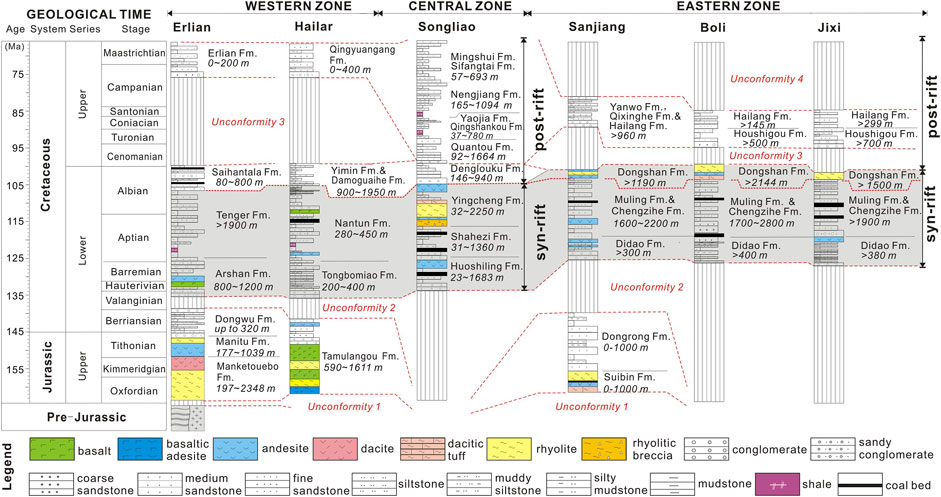
FIGURE 9. Stratigraphy of seven representative late Mesozoic basins in NE China (Zhang et al., 2017b).
During the Late Jurassic Period, the eastern basin went into a post-rift depressional stage with continuous subduction of the Pacific Plate (Huang et al., 2021; Li et al., 2021). Consequently, the Sanjiang basin connected with the Amur-Bureya basin and the Dongrong Fm’s littoral facies were deposited during a massive transgression (Jin et al., 2007).
5.2 Adjustments to the Paleo-Pacific Plate Subduction During the Early Lower Cretaceous
In the Lower Cretaceous (Valanginian), the Paleo-Pacific Plate rapidly subducted in an NNW direction towards the eastern margin of Eurasia (Maruyama et al., 1997). During the Asian continental plate convergence, the accreted-plates maintained a self-rotational motion due to continuous adjustment after accretion (Zhu et al., 2009; Hou et al., 2010; Yang, 2013), whereas there was significant strike-slip deformation between the plates (Halim et al., 1998; Metelkin et al., 2007; Metelkin et al., 2010), which could have been constrained by the Yangtze, North China, Pacific and Siberian Plates. The most significant strike-slips occurred during the Upper Jurassic to Lower Cretaceous, one of which was the Tanlu Fault Zone’s sinistral strike-slip ductile deformation (Uchimura et al., 1996). The strike-slip damaged the integrity of Eurasia’s eastern margin’s lithosphere and thinned of the Lower Cretaceous lithosphere. In Northeast Asia, it generated a wide shear stress field, causing numerous Palaeozoic suture zones to rejuvenate (Li et al., 2004; Zhu et al., 2006; Sun et al., 2008; Guo et al., 2018) (Figure 8C), resulting in a mass of strike-slip faults (Meng, 2003) and the widespread absence of early Lower Cretaceous (Valanginian) deposits (U2).
5.3 The Transition From an Extensional to Compressional Framework During the Middle-Late Lower Cretaceous
5.3.1 The Middle Lower Cretaceous
After the northward and north-westward subduction of the Pacific Plate, Northeast Asia’s the tectonic framework transformed from compressional to extensional during the Lower Cretaceous (Figure 8D). The thick deep crust and lithosphere underwent massive delamination from west to east (Wang et al., 2006; Zhang F. Q. et al., 2010; Zhang J. et al., 2010), resulting in the thinning of the lithosphere and intense magmatism in Northeast Asia (Kirillova, 2003; Shao et al., 2007; Tang et al., 2018). Numerous igneous rocks and sag basins were formed as a result. During the Lower Cretaceous, intense magma upwelling induced extensional tectonic events, followed by thermal cooling subsidence, causing the Northeast Asia Mesozoic basins to enter the syn-rift stage.
As a significant Cretaceous intra-continental rift basin on the Eurasian continent in the central zone, the Songliao Basin was formed and filled under the control of mantle upwelling and rifting (Li and Liu, 2015; Zhang F. et al., 2010). The basin bounded by normal faults comprised isolated grabens or half-grabens. In ascending order, the syn-rift strata included the Huoshiling (K1h), Shahezi (K1s), and Yingcheng (K1y) Fms (Figure 9) and the sediment thickness sediment reached 4,000 m in the south-eastern uplift zone (Xie et al., 2003).
In the EHLJ, the Jixi, Boli and Sanjiang basins deposited the Didao Fm during the early stage. During the Aptian phase, the basins expanded and underwent subsidence, enterING the depression stage. During a widespread transgression, the Mesozoic-Cenozoic residual basins in the EHLJ (i.e., the Jixi, Boli, Jiamusi, Sanjiang, Hegang basins) might have become well connected, regarded as the Cretaceous ‘Grand Sanjiang Unified Lake Basin’ (Sha et al., 2003; Sha, 2007; Wen et al., 2008; Sha and Galina, 2009; Jia and Zheng, 2010; Zhao et al., 2012; Zhao et al., 2017) comprising the coal-bearing strata of the Chengzihe and the Muleng Fms. The Sikhote-Alin Orogenic Belt uplifted, and deep faults in Northeast Asia (such as the Tanlu fault) began a sinistral strike-slip activity. Local volcanic activity occurred at the intersection of the NE and EW orientated faults (Zhao, 2011).
5.3.2 The Late Lower Cretaceous Period
Because of the plate’s slab roll-back during the late Lower Cretaceous (after the deposition of the Muleng Fm), local asthenospheric material upwelled, and fault and volcanic activities intensified (Li et al., 2007; He et al., 2009; Zhu Z. P. et al., 2009; Sun et al., 2013; Ling et al., 2017; Tang et al., 2018) (Figure 8E). Some scale of bimodal magmatism occurs in the Songliao Basin and the EHLJ, and the corresponding sedimentary strata are the Denglouku and Dongshan Fms. The Dongshan Fm was deposited in the EHLJ basins, containing of intermediate volcanic breccia, lithic tuff, altered basalt, siltstone, fine sandstone, and mudstone (Figure 9).
After the late Lower Cretaceous Period (Middle Albian), a massive collisional orogeny occurred in the eastern Eurasian margin (Figure 8E). The orogeny is named the Sakawa orogenesis in southwestern Japan (Kobayashi, 1941; Faure, 1985; Okada and Sakai, 2000) and the Minchen movement in south-eastern China (Gu, 2005). Based on research data, Vaughan (1995) highlighted that the collisional orogeny on the Pacific Rim occurred at 110–100 Ma, and generated wide thrust nappes and nonconformities. Sato et al. (2002) argued that the geodynamic and magmatic processes in Eurasia’s east margin in this stage were controlled by the Izanagi and Pacific Plates’ transition in configuration and style of convergence styles.
5.4 Compression System During the Upper Cretaceous Period
During the early Upper Cretaceous (Cenomanian), the Kula Plate began impinging on Eurasia and subducting after the Izanagi Plate entirely subducted under the Eurasia Plate, whereas the Pacific Plate subducted in a transformation from NNW to WNW (Maruyama et al., 1997; Northrup et al., 1995; Zhang et al., 2017a). These geodynamic movements shifted the Eurasian Plate’s eastern margin into an Andean-type continental margin (Sato et al., 2002). Based on thermochronological data in the Songliao Basin, Song et al. (2015) and Zhao et al. (2013) proposed that the Pacific-induced deformation at 87–89 Ma encompassed the entire eastern Asia from the subduction boundary to the hinterland. During these episodes, the large deep thrust faults (Zhang and Dong, 2008; Sun et al., 2010) developed under the large-scale orogeny domination (Han et al., 2008; Shi et al., 2008). In the EHLJ, after being extensively uplifted, some basins, such as the Jixi and the Boli Basins, became separated and experienced erosion. However, the Songliao Basin entered a post-rift stage (Figure 9).
The Upper Cretaceous stratigraphy in some Northeast Asia basins reveals internal angular unconformities and folds and thrust/reverse faults (Cho et al., 2016), indicating that the basins underwent compressional deformation episodes (Figure 8F). Two unconformities were displayed in the EHLJ, including those of the early Cenomanian–Turonian and the early Campanian–Maastrichtian consistent with the event of two discrete regional contractions in the Upper Cretaceous (Zhang et al., 2017b). In the Songliao Basin, two significant episodes of drainage pattern switches were found in the Upper Cretaceous strata, of which the thickness is up to 5 km, although no unconformities occurred in such a complete deposition (Wang et al., 2016; Zhang et al., 2017b).
With the subduction of the Kula Plate, a compression stress field entirely controlled NE China during the late Upper Cretaceous (Figure 8G). The basins underwent widely compressive deformation, accompanied by large-scale thrust, denudation and deplanation (Zhao et al., 2017). The intensive structural contraction lasted until the Paleogene, and divided the Cretaceous basin into individual ones, forming the present basin framework (Zhang et al., 2017b).
6 Conclusion
The data obtained seismic reflection profiles and field outcrops have revealed several regional Mesozoic unconformities in the EHLJ, NE China. The unconformities indicate that the two-sided active continental margin tectonics of the Mongolia-Okhotsk suture in the north during the Upper Jurassic and the Pacific Plate subduction in the east during the Cretaceous controlled the Mesozoic tectonic evolution of Northeast Asia.
(1)The U1 reflects the transitional environment from a convergent orogeny to an intra-continental extension in Northeast Asia during the Jurassic in response to the continental collision of Siberia and the northern China–Mongolia tract along the Mongolia–Okhotsk suture. The Lower Cretaceous/Jurassic angular unconformity (U2) results from numerous Palaeozoic suture zones and the activity of strike-slip faults at the eastern margin and in the neighbouring area of Eurasia, and indicating that the Paleo-Pacific Plate rapidly subducted in the NNW direction towards the Eurasia’s eastern margin.
(2)During the late Lower Cretaceous Period, subduction slab rollback of the Paleo-Pacific Plate resulted in the upwelling of local asthenospheric material, intensifying the fault and volcanic activity. The Lower Cretaceous Dongshan Fm/Muleng Fm unconformity (U3-1) reflects a scale of bimodal magmatism in the Songliao Basin and the EHLJ. During the early Upper Cretaceous (Cenomanian), the Kula Plate began impinging on Eurasia and subducting after the Izanagi Plate entirely subducted under the Eurasia Plate, whereas the Pacific Plate subducted in a transformation from NNW to WNW. Some the basins in the EHLJ, such as the Jixi and the Boli Basins, became separated at that epoch and experienced denudation after being extensively uplifted (U3). With the subduction of the Kula Plate, compression stress field controlled NE China during the later Upper Cretaceous. The EHLJ basins underwent widely compressive deformation, accompanied by large-scale thrusts, denudation and deplanation, and consequently Paleogene/Cretaceous unconformity (U4) was formed.
Data Availability Statement
The original contributions presented in the study are included in the article/Supplementary Material, further inquiries can be directed to the corresponding author.
Author Contributions
XZ contributed to the conception of the study and field works; CL and YJ performed the interpretation of seismic; XZ, HZ, and FW wrote the manuscript; PC helped perform the analysis with constructive discussions.
Funding
The National Natural Science Foundation of China (Grant Nos. 41672206, 41603041) funded this work. Financial support for this study was also partially supported by open fund (PLC20210203) of State Key Laboratory of Oil and Gas Reservoir Geology and Exploitation (Chengdu University of Technology).
Conflict of Interest
The authors declare that the research was conducted in the absence of any commercial or financial relationships that could be construed as a potential conflict of interest.
Publisher’s Note
All claims expressed in this article are solely those of the authors and do not necessarily represent those of their affiliated organizations, or those of the publisher, the editors and the reviewers. Any product that may be evaluated in this article, or claim that may be made by its manufacturer, is not guaranteed or endorsed by the publisher.
Acknowledgments
We appreciate it very much that the Daqing Oilfield Co. Ltd., PetroChina has provided us drilling data and seismic reflection data. We would also like to express our sincere thanks to Prof. Feng-qi Zhang, Dr. Jun Xiao and Xu Yan from Zhejiang University for their help with the field work.
Supplementary Material
The Supplementary Material for this article can be found online at: https://www.frontiersin.org/articles/10.3389/feart.2022.850324/full#supplementary-material
References
Cao, C. R., and Zheng, Q. D. (2003). Stuctural Evolution Features and its Significance of Hydrocerbon Exploration in Rilict Basin Group,Eastern Heilongjiang Province. J. Jilin Univ. (Earth Sci. Ed. 33 (2), 167–172. doi:10.1177/0144598719852419
Chen, C., Lee, C., and Shinjo, R. (2008). Was There Jurassic Paleo-Pacific Subduction in South China?: Constraints from 40Ar/39Ar Dating, Elemental and Sr–Nd–Pb Isotopic Geochemistry of the Mesozoic Basalts. Lithos 183 (1), 9–39. doi:10.1016/j.lithos.2008.06.009
Cho, H., Son, M., Cheon, Y., Sohn, Y. K., Kim, J.-S., and Kang, H.-C. (2016). Evolution of the Late Cretaceous Dadaepo Basin, SE Korea, in Response to Oblique Subduction of the Proto-Pacific (Izanagi/Kula) or Pacific Plate. Gondwana Res. 39 (Suppl. C), 145–164. doi:10.1016/j.gr.2016.07.004
Cui, F. H., Xu, X. C., Zheng, C. Q., Yao, W. G., and Shi, L. (2020). The Paleo-Pacific Plate Subduction and Slab Rollback beneath Eastern North China Craton: Insights from the Late Mesozoic Granitoids in Xingcheng Area. West. Liaoning Prov. 36 (08), 2463–2492. doi:10.18654/1000-0569/2020.08.12
Dilek, Y., and Sandvol, E. (2009). Seismic Structure, Crustal Architecture and Tectonic Evolution of the Anatolian-African Plate Boundary and the Cenozoic Orogenic Belts in the Eastern Mediterranean Region. Geol. Soc. Lond. Spec. Publ. 327 (1), 127–160. doi:10.1144/sp327.8
Duan, Y., Zhao, D., Zhang, X., Xia, S., Liu, Z., Wang, F., et al. (2009). Seismic Structure and Origin of Active Intraplate Volcanoes in Northeast Asia. Tectonophysics 173 (3), 197–206. doi:10.1016/j.tecto.2009.01.004
Faure, M., Natal'in, B. A., Monie, P., and Vrublevsky, A. A. (1995). Tectonic Evolution of the Anuy Metamorphic Rocks (Sikhote Alin, Russia) and Their Place in the Mesozoic Geodynamic Framework of East Asia. Tectonophysics 241 (3-4), 279. doi:10.1016/0040-1951(94)00186-d
Faure, M. (1985). The Pre-cretaceous Structure of the Outer Belt of Southwest Japan. Tectonophysics 113 (1), 139–162. doi:10.1016/0040-1951(85)90114-3
Guo, Z.-X., Shi, Y.-P., Yang, Y.-T., Jiang, S.-Q., Li, L.-B., and Zhao, Z.-G. (2018). Inversion of the Erlian Basin (NE China) in the Early Late Cretaceous: Implications for the Collision of the Okhotomorsk Block with East Asia. J. Asian Earth Sci. 154, 49–66. doi:10.1016/j.jseaes.2017.12.007
Halim, N., Kravchinsky, V., Gilder, S., Cogne, J., Alexyutin, M., Sorokin, A., et al. (1998). A Palaeomagnetic Study from the Mongol-Okhotsk Region: Rotated Early Cretaceous Volcanics and Remagnetized Mesozoic Sediments. Earth Planet. Sci. Lett. 159 (3-4), 133–145. doi:10.1016/s0012-821x(98)00072-7
Han, G. Q., Liu, Y. J., Li, J. J., Bai, J. Z., Sun, X. M., Wen, Q. B., et al. (2008). Uplifting Time of Huanan Uplift in the Northeastern Heilongjiang, China. J. Jilin Univ. (Earth Sci. Ed. 38 (3), 389–397. doi:10.3969/j.issn.1671-5888.2008.03.006
He, D. (2007). Structure of Unconformity and its Control on Hydrocarbon Accumulation. Petroleum Explor. Dev. 34 (2), 142–149. doi:10.3321/j.issn:1000-0747.2007.02.003
He, Z. H., Liu, Z. J., Zhang, X. D., Chen, Y. C., and Dong, L. S. (2009). Subdivisions of Structural Layers and Tectonic-Sedimentary Evolution of Eastern Basins in Heilongjiang in Late Mesozoic. Glob. Geol. 28 (1), 20–27. doi:10.3969/j.issn.1004-5589.2009.01.003
Heller, P. L., Angevine, C. L., Winslow, N. S., and Paola, C. (1988). Two-phase Stratigraphic Model of Foreland-Basin Sequences. Geol 16 (6), 501. doi:10.1130/0091-7613(1988)016<0501:tpsmof>2.3.co;2
Hou, G., Wang, Y., and Hari, K. R. (2010). The Late Triassic and Late Jurassic Stress Fields and Tectonic Transmission of North China Craton. J. Geodyn. 50 (3-4), 318–324. doi:10.1016/j.jog.2009.11.007
Huang, F., Zhang, Z., Xu, J., Li, X., Zeng, Y., Xu, R., et al. (2021). Lithospheric Extension in Response to Subduction of the Paleo-Pacific Plate: Insights from Early Jurassic Intraplate Volcanic Rocks in the Sk2 Borehole, Songliao Basin, NE China. Lithos 380–381, 105871. doi:10.1016/j.lithos.2020.105871
Huang, J., and Zhao, D. (2006). High-resolution Mantle Tomography of China and Surrounding Regions. J. Geophys. Research-Solid earth 111 (B9), 1–21. doi:10.1029/2005jb004066
Isozaki, Y., Aoki, K., Nakama, T., and Yanai, S. (2010). New Insight into a Subduction-Related Orogen: A Reappraisal of the Geotectonic Framework and Evolution of the Japanese Islands. Gondwana Res. 18 (1), 82–105. doi:10.1016/j.gr.2010.02.015
Jia, C. Z., and Zheng, M. (2010). Sedimentary History, Tectonic Evolution of Cretaceous Dasanjiang Basin in Northeast China and the Significance of Oil and Gas Exploration of its Residual Basins. J. Daqing Petroleum Inst. 34 (6), 1–12. doi:10.3969/j.issn.2095-4107.2010.06.001
Jin, S., Park, P., and Zhu, W. (2007). Micro-plate Tectonics and Kinematics in Northeast Asia Inferred from a Dense Set of GPS Observations. Earth Planet. Sci. Lett. 257 (3-4), 486–496. doi:10.1016/j.epsl.2007.03.011
Khanchuk, A. I., Kemkin, I. V., and Kruk, N. N. (2016). The Sikhote-Alin Orogenic Belt, Russian South East: Terranes and the Formation of Continental Lithosphere Based on Geological and Isotopic Data. J. Asian Earth Sci. 120, 117–138. doi:10.1016/j.jseaes.2015.10.023
Kirillova, G. L. (2003). Late Mesozoic–Cenozoic Sedimentary Basins of Active Continental Margin of Southeast Russia: Paleogeography, Tectonics, and Coal–Oil–Gas Presence. Mar. Petroleum Geol. 365 (1), 45–76. doi:10.1016/S0264-8172(03)00046-1
Kobayashi, T. (1941). The Sakawa Orogenic Cycle and its Bearing on the Origin of the Japanese Islands. Jour. Fac. Sci. Univ. Tokyo 2, 219–578.
Li, J. Y., Mo, S. G., He, Z. J., Sun, G. H., and Chen, W. (2004). The Timing of Crustal Sinistral Strike-Slip Movement in the Northern Great Khing' an Ranges and its Constraint on Reconstruction of the Crustal Tectonic Evolution of NE China and Adjacent Areas since the Mesozoic. Earth Sci. Front. 11 (03), 157–168. doi:10.3321/j.issn:1005-2321.2004.03.017
Lee, C. (2018). Initiation of Adakite Occurrence in Cretaceous Arc, Northeast Asia. Geosci. J. 22 (3), 383–391. doi:10.1007/s12303-017-0070-0
Li, C., and Liu, S. (2015). Cretaceous Anomalous Subsidence and its Response to Dynamic Topography in the Songliao Basin, Northeast China. J. Asian Earth Sci. 109, 86–99. doi:10.1016/j.jseaes.2015.04.045
Li, C. W., Guo, F., Fan, W. M., and Gao, X. F. (2007). Ar-Ar Chronology of Late Mesozoic Volcanic Rocks in Yanji Area and its Tectonic Significance. Sci. China (Series D). 37 (03), 319–330. doi:10.3969/j.issn.1674-7240.2007.03.004
Li, K.-m., Wang, Y., Zhao, J.-h., Zhao, H.-l., and Di, Y.-j. (2003). Mantle Plume, Large Igneous Province and Continental Breakup. Acta seimol. Sin. 16 (3), 330–339. doi:10.1007/s11589-003-0037-2
Li, S., Chen, F., Siebel, W., Wu, J., Zhu, X., Shan, X., et al. (2012). Late Mesozoic Tectonic Evolution of the Songliao Basin, NE China: Evidence from Detrital Zircon Ages and Sr–Nd Isotopes. Gondwana Res. 22 (3), 943–955. doi:10.1016/j.gr.2012.04.002
Li, Z.-Q., Chen, J.-L., Zou, H., Wang, C.-S., Meng, Q.-A., Liu, H.-L., et al. (2021). Mesozoic-Cenozoic Tectonic Evolution and Dynamics of the Songliao Basin, NE Asia: Implications for the Closure of the Paleo-Asian Ocean and Mongol-Okhotsk Ocean and Subduction of the Paleo-Pacific Ocean. Earth-science Rev. 218, 103471. doi:10.1016/j.earscirev.2020.103471
Ling, Y.-Y., Zhang, J.-J., Liu, K., Ge, M.-H., Wang, M., and Wang, J.-M. (2017). Geochemistry, Geochronology, and Tectonic Setting of Early Cretaceous Volcanic Rocks in the Northern Segment of the Tan-Lu Fault Region, Northeast China. J. Asian Earth Sci. 144, 303–322. doi:10.1016/j.jseaes.2016.12.025
Liu, J., Han, J., and Fyfe, W. S. (2001). Cenozoic Episodic Volcanism and Continental Rifting in Northeast China and Possible Link to Japan Sea Development as Revealed from K–Ar Geochronology. Tectonophysics 247 (1), 144–161. doi:10.1016/S0040-1951(01)00132-9
Liu, M., Cui, X., and Liu, F. (2004). Cenozoic Rifting and Volcanism in Eastern China: A Mantle Dynamic Link to the Indo-Asian Collision? Tectonophysics 393, 39–42. doi:10.1016/j.tecto.2004.07.029
Liu, Y. W., Tang, Z. G., and Liu, L. W. (2006). Evolutional Characteristics of Sanjiang Basin and Direction of Hydrocarbon Exploration. J. Oil Gas Technol. 28 (2), 1–5. doi:10.3969/j.issn.1000-9752.2006.02.001
Ma, X.-H., Zhu, W.-P., Zhou, Z.-H., and Qiao, S.-L. (2017). Transformation from Paleo-Asian Ocean Closure to Paleo-Pacific Subduction: New Constraints from Granitoids in the Eastern Jilin-Heilongjiang Belt, NE China. J. Asian Earth Sci. 144, 261–286. doi:10.1016/j.jseaes.2016.11.003
Maruyama, S., Isozaki, Y., Kimura, G., and Terabayashi, M. (1997). Paleogeographic Maps of the Japanese Islands: Plate Tectonic Synthesis from 750 Ma to the Present. Isl. Arc 6 (1), 121–142. doi:10.1111/j.1440-1738.1997.tb00043.x
Men, X. Y., Li, X. F., and Li, M. (2010). Structural Evolution and Oil/Gas Prospects of Basin Groups East of Songliao Peripheral Basins. China Pet. Explor. 15 (3), 7–10. doi:10.3969/j.issn.1672-7703.2010.03.002
Meng, E., Xu, W., Pei, F., Yang, D., Yu, Y., and Zhang, X. (2010). Detrital-zircon Geochronology of Late Paleozoic Sedimentary Rocks in Eastern Heilongjiang Province, NE China: Implications for the Tectonic Evolution of the Eastern Segment of the Central Asian Orogenic Belt. Tectonophysics 485 (1-4), 42–51. doi:10.1016/j.tecto.2009.11.015
Meng, Q. (2003). What Drove Late Mesozoic Extension of the Northern China–Mongolia Tract? Tectonophysics 253 (1), 76–85. doi:10.1016/s0040-1951(03)00195-1
Metelkin, D. V., Vernikovsky, V. A., Kazansky, A. Y., and Wingate, M. T. D. (2010). Late Mesozoic Tectonics of Central Asia Based on Paleomagnetic Evidence. Gondwana Res. 18 (2-3), 400–419. doi:10.1016/j.gr.2009.12.008
Metelkin, D. V., Gordienko, I. V., and Klimuk, V. S. (2007). Paleomagnetism of Upper Jurassic Basalts from Transbaikalia: New Data on the Time of Closure of the Mongol-Okhotsk Ocean and Mesozoic Intraplate Tectonics of Central Asia. Russ. Geol. Geophys. 48 (10), 825–834. doi:10.1016/j.rgg.2007.09.004
Northrup, C. J., Royden, L. H., and Burchfiel, B. C. (1995). Motion of the Pacific Plate Relative to Eurasia and its Potential Relation to Cenozoic Extension along the Eastern Margin of Eurasia. Geol 23 (8), 719–722. doi:10.1130/0091-7613(1995)023<0719:motppr>2.3.co;2
Okada, H., and Sakai, T. (2000). “The Cretaceous System of the Japanese Islands and its Physical Environments,” in Developments in Palaeontology and Stratigraphy (Amsterdam: Elsevier), 113–144. doi:10.1016/s0920-5446(00)80027-8
Ren, J., Tamaki, K., Li, S., and Junxia, Z. (2002). Late Mesozoic and Cenozoic Rifting and its Dynamic Setting in Eastern China and Adjacent Areas. Tectonophysics 13 (3), 305–315. doi:10.1016/s0040-1951(01)00271-2
Sato, K., Vrublevsky, A. A., Rodionov, S. M., Romanovsky, N. P., and Nedachi, M. (2002). Mid-Cretaceous Episodic Magmatism and Tin Mineralization in Khingan-Okhotsk Volcano-Plutonic Belt, Far East Russia. Resour. Geol. 52 (1), 1–14. doi:10.1111/j.1751-3928.2002.tb00112.x
Sha, J. (2007). Current Research on Cretaceous Lake Systems in Northeast China. Cretac. Res. 28, 143–145. doi:10.1016/j.cretres.2007.02.001
Sha, J., Matsukawa, M., Cai, H., Jiang, B., Ito, M., He, C., et al. (2003). The Upper Jurassic-Lower Cretaceous of Eastern Heilongjiang, Northeast China: Stratigraphy and Regional Basin History. Cretac. Res. 24, 715–728. doi:10.1016/j.cretres.2003.07.006
Sha, J., Wang, J., Kirillova, G., Pan, Y., Cai, H., Wang, Y., et al. (2009). Upper Jurassic and Lower Cretaceous of Sanjiang-Middle Amur Basin: Non-marine and Marine Correlation. Sci. China Ser. D-Earth Sci. 52 (12), 1873–1889. doi:10.1007/s11430-009-0173-1
Shao, J. A., Zhang, L. Q., Mu, B. L., and Han, Q. J. (2007). Upwelling of Da Hinggan Mountains and its Geodynamic Background. Beijing: Geological press, 254.
Shao, J. (1995). Terranes in Northeast China and Evolution of Northeast Asia Continental Margin. Beijing: Earthquake Press, 185.
Shi, F., Xin-rong, Z., Zhao-jun, L., He-yong, W., and Jian-guo, Y. (2008). Thrust Event of the Provenances Revealed by Zircon Fission Track Ages in Tangyuan Fault-Basin, NE China. Radiat. Meas. 43 (Suppl. 1), S324–S328. doi:10.1016/j.radmeas.2008.04.079
Song, J. G., Dou, L. R., and Li, J. Z. (1996). Tectonics and Petroliferous Systems of Late Mesozoic Basins in China. Acta Pet. Sin. 17 (4), 1–7.
Song, T. (1997). Inversion Styles in the Songliao Basin (Northeast China) and Estimation of the Degree of Inversion. Tectonophysics 283 (1-4), 173–188. doi:10.1016/s0040-1951(97)00147-9
Song, Y., Stepashko, A. A., and Ren, J. (2015). The Cretaceous Climax of Compression in Eastern Asia: Age 87-89 Ma (Late Turonian/Coniacian), Pacific Cause, Continental Consequences. Cretac. Res. 55, 262–284. doi:10.1016/j.cretres.2015.01.002
Sun, M.-D., Chen, H.-L., Zhang, F.-Q., Wilde, S. A., Dong, C.-W., and Yang, S.-F. (2013). A 100Ma Bimodal Composite Dyke Complex in the Jiamusi Block, NE China: An Indication for Lithospheric Extension Driven by Paleo-Pacific Roll-Back. Lithos 162-163, 317–330. doi:10.1016/j.lithos.2012.11.021
Sun, X. M., Liu, Y. J., Chun, S. Q., Han, G. Q., Qin, W. S., and De, W. Y. (2008). 40Ar/39Ar Geochronology Evidence of Strike-Slip Movement in Dunhua-Mishan Fault Zone. J. Jilin Univ. (Earth Sci. Ed. 38 (06), 965–972. doi:10.3969/j.issn.1671-5888.2008.06.009
Sun, X., Wang, S., Wang, Y., Du, J., and Xu, Q. (2010). The Structural Feature and Evolutionary Series in the Northern Segment of Tancheng-Lujiang Fault Zone. Acta Petrol. Sin. 26 (1), 165–176.
Tang, J., Xu, W., Wang, F., and Ge, W. (2018). Subduction History of the Paleo-Pacific Slab beneath Eurasian Continent: Mesozoic-Paleogene Magmatic Records in Northeast Asia. Sci. China Earth Sci. 61 (5), 527–559. doi:10.1007/s11430-017-9174-1
Uchimura, H., Kono, M., Tsunakawa, H., Kimura, G., Wei, Q., Hao, T., et al. (1996). Paleomagnetism of Late Mesozoic Rocks from Northeastern China: the Role of the Tan-Lu Fault in the North China Block. Tectonophysics 262, 301–319. doi:10.1016/0040-1951(96)00016-9
Vaughan, A. P. M. (1995). Circum-Pacific Mid-cretaceous Deformation and Uplift: A Superplume-Related Event? Geol 23 (6), 491–494. doi:10.1130/0091-7613(1995)023<0491:cpmcda>2.3.co;2
Walker, J. D., Geissman, J. W., Bowring, S. A., and Le Babcock, (2013). The Geological Society of America Geologic Time Scale. Geol. Soc. Am. Bull. 125 (3-4), 259–272. doi:10.1130/b30712.1
Walter, H. B. (1952). Geologic Structure and Orogenic History of Venezuela. New York: Geological Society of Americ.
Wang, C. W., Sun, Y. W., Li, N., Zhao, G. W., and Ma, X. Q. (2009). Late Paleozoic Stratigraphic Distribution Laws and its Tectonic Significance in Northeastern china and Adjacent Areas. Sci. China (D earth Sci. 39 (10), 1429–1437. doi:10.1007/s11430-009-0062-7
Wang, F., Zhou, X. H., Zhang, L. C., Ying, J. F., Zhang, Y. T., Wu, F. Y., et al. (2006). Late Mesozoic Volcanism in the Great Xing'an Range (NE China): Timing and Implications for the Dynamic Setting of NE Asia. Earth Planet. Sci. Lett. 251 (1-2), 179–198. doi:10.1016/j.epsl.2006.09.007
Wang, P., Liu, W., Wang, S., and Song, W. (2001). 40Ar/39Ar and K/Ar Dating on the Volcanic Rocks in the Songliao Basin, NE China: Constraints on Stratigraphy and Basin Dynamics. Int. J. Earth Sci. 91 (2), 640. doi:10.1007/s005310100219
Wang, P.-J., Mattern, F., Didenko, N. A., Zhu, D.-F., Singer, B., and Sun, X.-M. (2016). Tectonics and Cycle System of the Cretaceous Songliao Basin: An Inverted Active Continental Margin Basin. Earth-Science Rev. 159, 82–102. doi:10.1016/j.earscirev.2016.05.004
Wang, X. W. (1997). Meso-cenozoic Tectonic Event and Evolution of Northeastern Asia Continental Margin. Geol. Sci. Technol. Inf. 16 (4), 9–15.
Wen, Q. B., Liu, Y. J., Han, G. Q., Sun, X. M., Zhan, Y. L., and Li, W. (2008). Mesozoic and Cenozoic Tectonic Evolution of the Basin Group in Eastern Heilongjiang,China. Glob. Geol. 27 (4), 370–377. doi:10.3969/j.issn.1004-5589.2008.04.004
Whan, O. C. (20062006). A New Concept on Tectonic Correlation between Korea, China and Japan: Histories from the Late Proterozoic to Cretaceous. Gondwana Res. 9, 47–61. doi:10.1016/j.gr.2005.06.001
Wilson, T. J. (1991). Transition from Back-Arc to Foreland Basin Development in the Southernmost Andes: Stratigraphic Record from the Ultima Esperanza District, Chile. Geol. Soc. Am. Bull. 103 (1), 98–111. doi:10.1130/0016-7606(1991)103<0098:tfbatf>2.3.co;2
Wu, H. Y., Wang, S. H., Yang, J. G., Tang, Z. H., Wang, Z. J., and Zhang, Q. S. (2004). Analysis of Exploration Potential in Surrounding Basins of Daqing Oilfield. China Pet. Explor. 9 (4), 23–30. doi:10.3969/j.issn.1672-7703.2004.04.005
Xie, X., Jiao, J. J., Tang, Z., and Zheng, C. (2003). Evolution of Abnormally Low Pressure and its Implications for the Hydrocarbon System in the Southeast Uplift Zone of Songliao Basin, China. Aapg Bull. 87 (1), 99–119. doi:10.1306/080602870099
Yang, D.-G., Sun, D.-Y., Gou, J., and Hou, X.-G. (2017). U-pb Ages of Zircons from Mesozoic Intrusive Rocks in the Yanbian Area, Jilin Province, NE China: Transition of the Paleo-Asian Oceanic Regime to the Circum-Pacific Tectonic Regime. J. Asian Earth Sci. 143, 171–190. doi:10.1016/j.jseaes.2017.04.019
Yang, X., Li, W., and Batten, D. J. (2007). Biostratigraphic and Palaeoenvironmental Implications of an Early Cretaceous Miospore Assemblage from the Muling Formation, Jixi Basin, Northeast China. Cretac. Res. 28, 339–347. doi:10.1016/j.cretres.2006.07.008
Yang, Y.-T. (2013). An Unrecognized Major Collision of the Okhotomorsk Block with East Asia during the Late Cretaceous, Constraints on the Plate Reorganization of the Northwest Pacific. Earth-Science Rev. 126, 96–115. doi:10.1016/j.earscirev.2013.07.010
Yin, A. (2010). Cenozoic Tectonic Evolution of Asia: A Preliminary Synthesis. Tectonophysics 488 (1-4), 293–325. doi:10.1016/j.tecto.2009.06.002
Zhang, C. H., and Zhang, S. H. (1999). Proto-basin and Possible Orogenic Mechanism of Wandashan Orogenic Belt. Geoscience 13 (01), 25–31. doi:10.1006/mcpr.1998.0211
Zhang, F. Q., Chen, H. L., Yu, X., Dong, C. W., Yang, S. F., Pang, Y. M., et al. (2010). Early Cretaceous Volcanism in the Northern Songliao Basin, NE China, and its Geodynamic Implication. Gondwana Res. 369 (3), 155–174. doi:10.1016/j.gr.2010.03.011
Zhang, F.-Q., Chen, H.-L., Batt, G. E., Dilek, Y., Min-Na, A., Ming-Dao, S., et al. (2015). Detrital Zircon U-Pb Geochronology and Stratigraphy of the Cretaceous Sanjiang Basin in NE China: Provenance Record of an Abrupt Tectonic Switch in the Mode and Nature of the NE Asian Continental Margin Evolution. Tectonophysics 665, 58–78. doi:10.1016/j.tecto.2015.09.028
Zhang, F.-Q., Chen, H.-L., Yang, S.-F., Feng, Z.-Q., Wu, H.-Y., Batt, G. E., et al. (2012). Late Mesozoic-Cenozoic Evolution of the Sanjiang Basin in NE China and its Tectonic Implications for the West Pacific Continental Margin. J. Asian Earth Sci. 49, 287–299. doi:10.1016/j.jseaes.2011.12.017
Zhang, F.-Q., Dilek, Y., Chen, H.-L., Yang, S.-F., and Meng, Q.-A. (2017a). Late Cretaceous Tectonic Switch from a Western Pacific- to an Andean-type Continental Margin Evolution in East Asia, and a Foreland Basin Development in NE China. Terra nova. 29 (6), 335–342. doi:10.1111/ter.12286
Zhang, F.-Q., Dilek, Y., Chen, H.-L., Yang, S.-F., and Meng, Q.-A. (2017b). Structural Architecture and Stratigraphic Record of Late Mesozoic Sedimentary Basins in NE China: Tectonic Archives of the Late Cretaceous Continental Margin Evolution in East Asia. Earth-Science Rev. 171 (Suppl. C), 598–620. doi:10.1016/j.earscirev.2017.05.015
Zhang, J., Gao, S., Ge, W., Wu, F., Yang, J., Wilde, S. A., et al. (2010). Geochronology of the Mesozoic Volcanic Rocks in the Great Xing'an Range, Northeastern China: Implications for Subduction-Induced Delamination. Chem. Geol. 2010 (276), 144–165. doi:10.1016/j.chemgeo.2010.05.013
Zhang, S. H., and Shi, Y. S. (1993). The Deep Structure of Liamusi Terrane, Heilongjiang Province. Geotect. Metallogenia 17 (1), 93–101.
Zhang, X., Zhang, H., Wilde, S. A., Yang, Y., and Chen, H. (2010). Late Permian to Early Triassic Mafic to Felsic Intrusive Rocks from North Liaoning, North China: Petrogenesis and Implications for Phanerozoic Continental Crustal Growth. Lithos 17 (1), 125–134. doi:10.1016/j.lithos.2010.03.005
Zhang, Y. P., Ren, J. Y., Wang, S., and Zhao, X. Q. (2016). The Sedimentary Evidence for the Existence of Unified Basin in Early Cretaceous in Dasanjiang Basin Group, Northeast China. Geol. China 43 (4), 1280–1290. doi:10.12029/gc20160414
Zhang, Y. Q., and Dong, S. W. (2008). Mesozoic Tectonic Evolution History of the Tan-Lu Fault Zone, China: Advances and New under Standing. Geol. Bull. China 27 (9), 1371–1390. doi:10.3969/j.issn.1671-2552.2008.09.002
Zhang, Y. Q., Qian, X. L., and Li, J. H. (2001). The Spread of Long-Range Effects from Plate Collision and the Movement the Earth's Layers. Earth Sci. Front. 8 (04), 341–342.
Zhao, B., Wang, C., Wang, X., and Feng, Z. (2013). Late Cretaceous (Campanian) Provenance Change in the Songliao Basin, NE China: Evidence from Detrital Zircon U-Pb Ages from the Yaojia and Nenjiang Formations. Palaeogeogr. Palaeoclimatol. Palaeoecol. 385 (Suppl. C), 83–94. doi:10.1016/j.palaeo.2012.03.017
Zhao, X. Q. (2011). Structural Deformation and Evolution of the Mesozoic-Cenozoic Basins in Eastern Heilongjiang. NE China. [D]. Hangzhou: Zhejiang University.
Zhao, X., Chen, H., Zhang, F., Sun, M., Yang, J., and Tan, B. (2017). Characteristics, Structural Styles and Tectonic Implications of Mesozoic-Cenozoic Faults in the Eastern Heilongjiang Basins (NE China). J. Asian Earth Sci. 146, 196–210. doi:10.1016/j.jseaes.2017.05.004
Zhao, X. Q., Yang, S. F., Chen, H. L., Zhang, F. Q., Zhang, Y. P., Yang, C. Z., et al. (2012). Features of Multistage Cretaceous Conglomerate Deposition and its Palaeogeographic Significance in Jixi Basin of Eastern Heilongjiang, NE China. Acta Sci. Nat. Univ. Pekin. 48 (3), 27–29.
Zhou, J., Wilde, S. A., Zhang, X., Zhao, G., Zheng, C., Wang, Y., et al. (2009). The Onset of Pacific Margin Accretion in NE China: Evidence from the Heilongjiang High-Pressure Metamorphic Belt. Tectonophysics 478 (3-4), 230–246. doi:10.1016/j.tecto.2009.08.009
Zhou, J.-B., Wilde, S. A., Zhao, G.-C., Zhang, X.-Z., Zheng, C.-Q., Wang, H., et al. (2010). Pan-African Metamorphic and Magmatic Rocks of the Khanka Massif, NE China: Further Evidence Regarding Their Affinity. Geol. Mag. 147 (5), 737–749. doi:10.1017/s0016756810000063
Zhu, G., Shi, Y., and Tackley, P. (2010). Subduction of the Western Pacific Plate underneath Northeast China: Implications of Numerical Studies. Phys. Earth Planet. Interiors 277 (1), 244–252. doi:10.1016/j.pepi.2009.10.008
Zhu, G., Liu, G. S., Niu, M. L., Xie, C. L., Wang, Y. S., and Xiang, B. (2009). Syn-collisional Transform Faulting of the Tan-Lu Fault Zone, East China. Int. J. Earth Sci. Geol. Rundsch) 98 (1), 135–155. doi:10.1007/s00531-007-0225-8
Zhu, G., Xu, Y. D., Liu, G. S., Wang, Y. S., and Xie, C. L. (2006). Structural and Deformational Characteristics of Strike-Slippings along the Middle-Southern Sector of the Tan-Lu Fault Zone. China Geol. 41 (2), 226–241.
Zhu, Y., and He, C. (2007). Middle Jurassic to Early Cretaceous Dinoflagellate Assemblage Zones in Eastern Heilongjiang Province, Northeast China. Cretac. Res. 28, 327–332. doi:10.1016/j.cretres.2006.10.001
Zhu, Z. P., Liu, L., Ma, R., Qiu, Z. K., and Ma, S. H. (2009). 40Ar/39Ar Isotopic Dating and Geological Significance of Mafic Rocks from the Jixi Basin, Heilongjiang Province. J. Jilin Univ. (Earth Sci. Ed. 39 (2), 238–243. doi:10.3969/j.issn.1671-5888.2009.02.010
Zonenshain, L. P., Kuzmin, M. I., and Natapov, L. M. (1990). Geology of the USSR: A Plate Tectonic Synthesis. Washington: Am. Geophys. Union Geodyn..
Keywords: unconformities, geodynamic characteristics, Mesozoic, continental margin, Northeast Asian
Citation: Zhao X, Lv C, Jiang Y, Zhu H, Wang F and Chai P (2022) Geological Characteristics of the Mesozoic Unconformities in Eastern Heilongjiang, NE China: Implications for the Mesozoic Continental Margin Evolution of Northeast Asia. Front. Earth Sci. 10:850324. doi: 10.3389/feart.2022.850324
Received: 07 January 2022; Accepted: 24 June 2022;
Published: 25 July 2022.
Edited by:
Xiubin Lin, Zhejiang University, ChinaReviewed by:
Boris Alekseevich Natalin, Istanbul Technical University, TurkeyDianjun Tong, China University of Geosciences Wuhan, China
Copyright © 2022 Zhao, Lv, Jiang, Zhu, Wang and Chai. This is an open-access article distributed under the terms of the Creative Commons Attribution License (CC BY). The use, distribution or reproduction in other forums is permitted, provided the original author(s) and the copyright owner(s) are credited and that the original publication in this journal is cited, in accordance with accepted academic practice. No use, distribution or reproduction is permitted which does not comply with these terms.
*Correspondence: Xueqin Zhao, enhxY2hAc2luYS5jb20=
 Xueqin Zhao
Xueqin Zhao Congcong Lv1
Congcong Lv1 Yaoxi Jiang
Yaoxi Jiang